"HODLing ETH is the biggest mistake I've made in this cycle."
Author: Ignas | DeFi Research
Compiled by: Deep Tide TechFlow
As part of finance and trading, what fascinates me about the crypto market is that it clearly tells you what is right and what is wrong.
Especially in this chaotic world, where the lines between truth and lies are blurred in politics, art, journalism, and many other industries. But cryptocurrency is simple and straightforward: If you are right, you make money; if you are wrong, you lose money. It's that simple.
Even so, I fell into a very basic trap: When market conditions changed, I did not reassess my portfolio. While trading altcoins, I became overly complacent with those "untouchable HODL" assets, like ETH.
Of course, adapting to new realities is easier said than done.
There are too many variables to consider, so we often choose simple narratives like HODL (hold on for dear life) because it doesn't require us to actively monitor the market.
But what if the era of HODL has ended? In this ever-changing world, what is the role of cryptocurrency? What have we missed?
In this blog, I will share what I believe to be significant changes happening in the market.
The End of the HODL Era
Let's travel back to early 2022:
The price of ETH lingered around $3,000 after a significant drop from a previous high of $4,800. BTC was around $42,000. However, due to interest rate hikes, the collapse of centralized finance (CeFi), and the downfall of FTX, both subsequently dropped by 50%.
Despite this, the Ethereum community remained optimistic: ETH was about to migrate to PoS (Proof of Stake), and a few months prior, the EIP proposal for ETH burning had just been launched. The narrative of ETH as "Ultrasound Money" and an environmentally friendly, energy-efficient blockchain was very popular.
However, for the remainder of 2022, ETH and BTC performed poorly, while SOL faced a brutal decline, plummeting 96% to just $8.
Ethereum won the L1 (Layer 1 network) war, while other L1s either migrated to L2 (Layer 2 network) or faced extinction.
I remember attending conferences during the bear market where most people firmly believed that ETH would rebound the strongest, so they bought a lot of ETH while underweighting BTC, completely ignoring SOL. The strategy was simple: HODL, then sell at the peak of the bull market in 2024/25. Easy peasy.
However, reality hit hard!
Since then, SOL has rebounded, while Ethereum faced the strongest panic selling (FUD) in history.
The narrative of "Ultrasound Money" is dead (at least for now), and the environmental (ESG) narrative never really took off.
HODLing ETH is the biggest mistake I've made in this cycle. I believe this is a common regret for many.

My bullish logic for ETH was that it would become the most productive asset in the crypto market.
Through restaking, ETH would gain "superpowers," not only protecting Ethereum but also safeguarding the entire critical DeFi and crypto infrastructure. The restaking yields for ETH would soar, and airdrop rewards would continuously accumulate through restaked ETH.
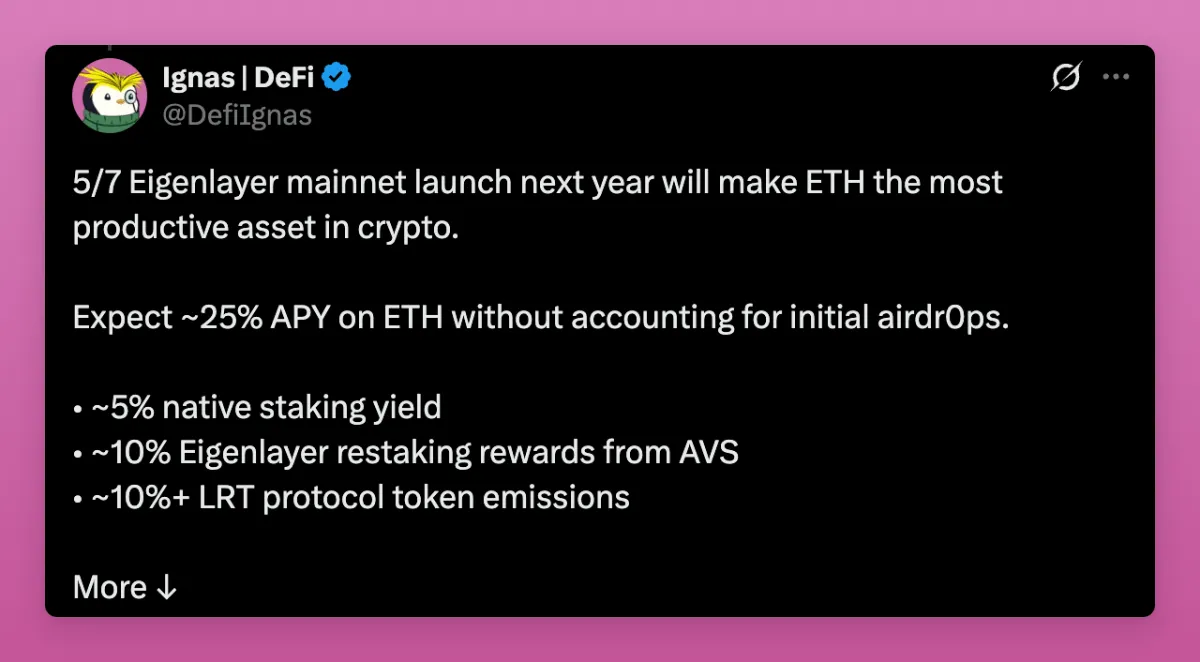
As yields increased, demand and price for ETH should rise. In summary: to the moon!
Clearly, this did not happen, as the value proposition of restaking was never clear, and Eigenlayer performed poorly in its token issuance.
So, what does all this have to do with the demise of the HODL metaverse?
For many, ETH has always been an asset to "buy and forget." If BTC goes up, ETH usually rises even more, making holding BTC seem pointless.
When my bullish logic for ETH based on the restaking narrative failed to materialize, I should have recognized and adjusted my strategy in a timely manner. However, I became lazy and complacent, unwilling to admit my mistakes. I told myself: ETH will rebound one day, right?
HODL is not only bad advice for ETH, but even worse for other assets, with perhaps the only exception being BTC (which I will discuss later).
The crypto market changes too quickly; it is unrealistic to expect to hold an asset for months or even years and retire. A look at the charts shows that most altcoins have given back their gains from this bull market cycle. Clearly, profits come from selling, not holding.
A successful meme coin trader stated that instead of HODLing, he typically holds a meme coin for even less than a minute.
Although some still try to sell you the dream of HODL, it feels more like a "quick in and out" cycle rather than true HODL.

BTC is the Only Macro Crypto Asset
In the "quick in and out" strategy, the only exception is BTC.
Some attribute BTC's strong performance to Michael Saylor's "infinite buy orders," as we have successfully promoted BTC as "digital gold" to institutional investors.
However, this battle is far from over.
Many crypto commentators still view BTC as a highly volatile risk asset, similar to betting on the S&P 500.
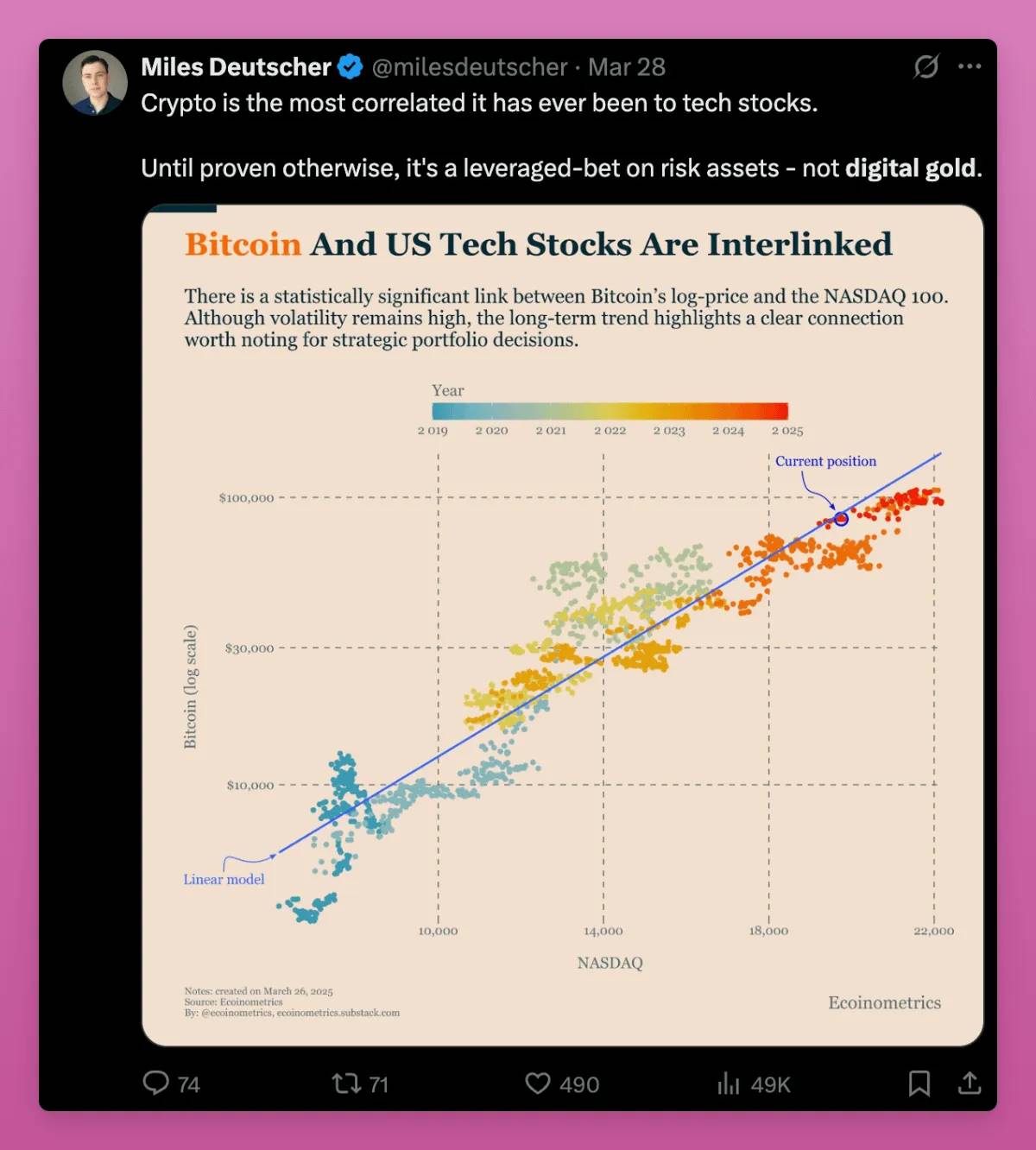
This view contradicts research from Blackrock. Blackrock found that the risk and return drivers of BTC differ from traditional risk assets, making it unsuitable for the "risk on/risk off" model used by some macroeconomic commentators.
In my article Crypto Truths and Lies for 2025: What Do You Believe is the Truth?, I shared some observations on non-obvious truths.
I believe Bitcoin (BTC) is shifting from the hands of those who see it as a high-leverage stock bet to those who view it as a digital, safe-haven, gold-like asset. Mexican billionaire Ricardo Salinas is an example, as he insists on holding BTC.
BTC is the only true macro crypto asset. The value of ETH, SOL, and other crypto assets is typically assessed based on transaction fees, trading volume, and total value locked (TVL), while BTC has transcended these frameworks to become a macro asset that even Peter Schiff can understand.
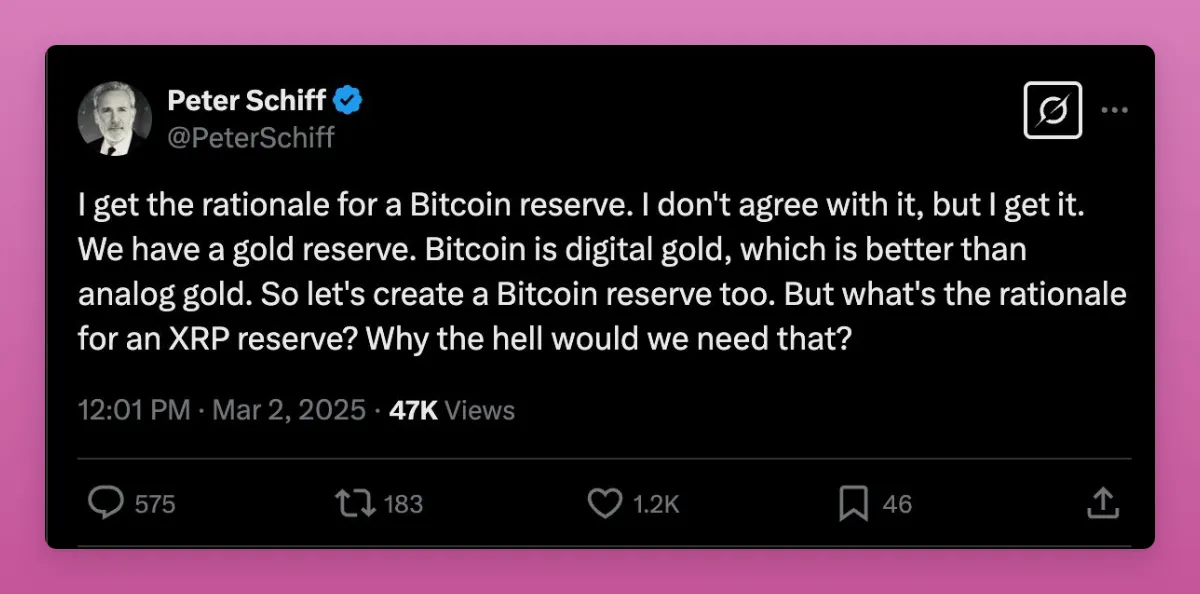
This transition is not yet complete, but the shift from risk asset to safe-haven asset presents an opportunity. Once BTC is widely recognized as a safe-haven asset, its price will reach $1 million.
Corruption in the Private Market
When every relatively successful key opinion leader (KOL) starts transforming into "venture capitalists" (VCs), investing in projects at low valuations and dumping them after token generation events (TGE), I sensed something was wrong in the market.
However, nothing describes the current state of the crypto private market better than Noah's post.
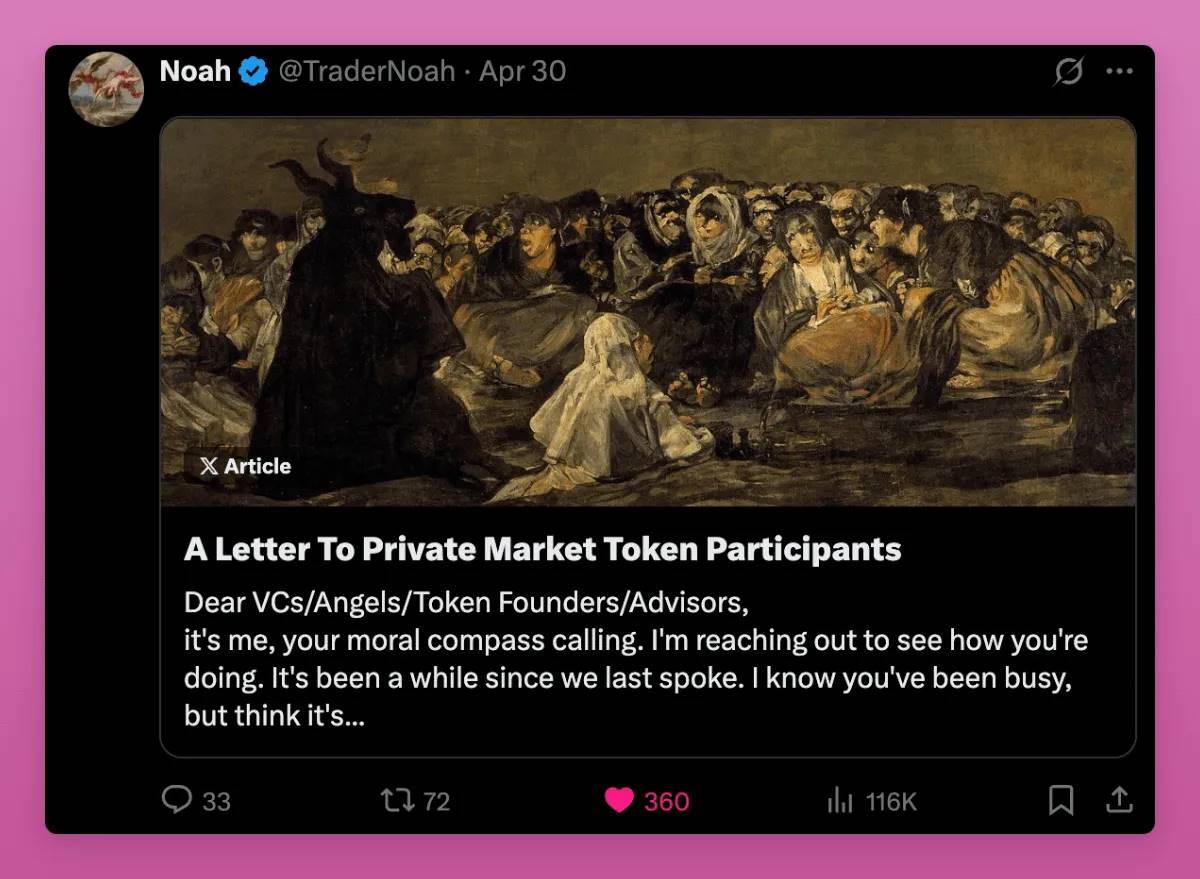
Here are the core changes in the private market over the past few years:
In the early days (2015-2019), participants in the private market were true believers. They supported Ethereum, funded DeFi pioneers like MakerDAO and ETHLend (now Aave), and advocated for long-term holding (HODLing).
The goal was not just to make quick profits but to create something meaningful.
By the time of the DeFi summer of 2020-2022, everything changed. Suddenly, everyone was chasing newer, hotter tokens.
Venture capital firms (VCs) poured money into absurdly valued, utterly impractical token projects.
The game was simple: participate in the private round at a low price, hype the project, and then dump the tokens to retail investors. When these projects collapsed, we should have learned from it, but nothing changed.
After the FTX incident (2023-2025), the private market became even more nihilistic. VCs began funding "soulless token machines" (i.e., projects that recycle old ideas, with questionable founder backgrounds (like Movement), and no real use cases).
Private round valuations were set at 50 times revenue (if the project had revenue), ultimately leading the public market to absorb these losses. The result was that 80% of tokens fell below their private round prices within six months of listing in 2024.
This is a predatory phase.
Today, retail trust has evaporated, and VCs are in disarray.
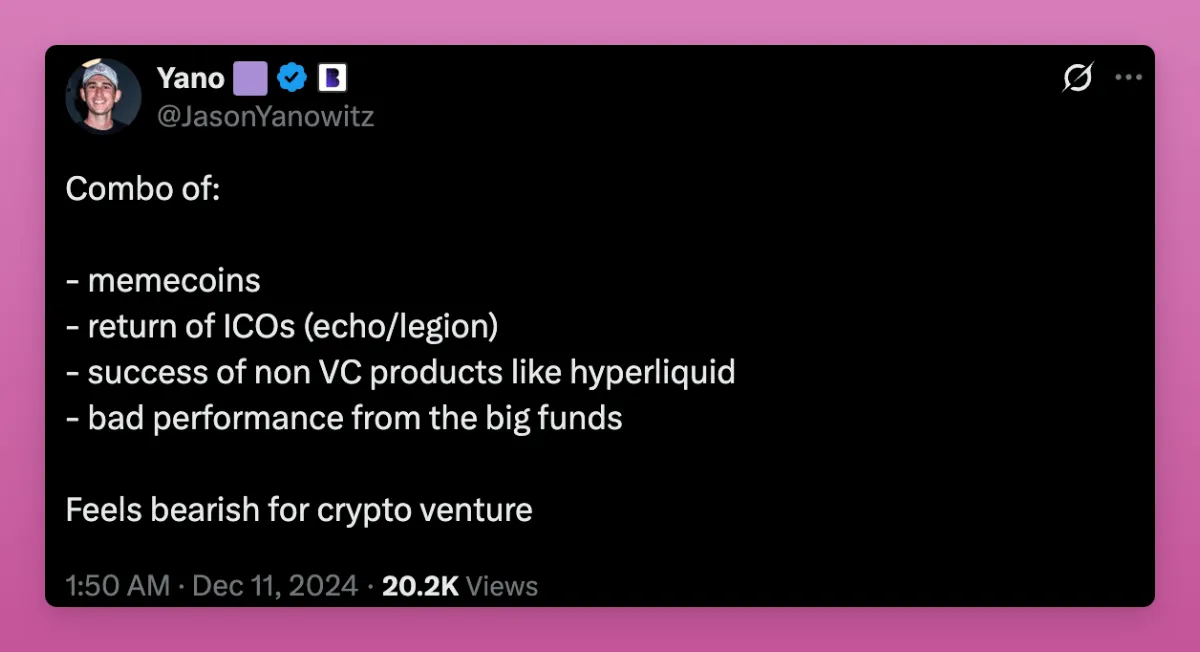
Many VC-backed projects are trading below their seed round valuations, and some of my KOL friends are deeply in the red.
However, there are signs of recovery in the private market:
- The co-founder of Movement and Gabagool (the former "runner" of Aerodrome) faced public backlash and was ousted from the industry. We need more such clean-up actions.

- Valuations in the private and public markets are declining.
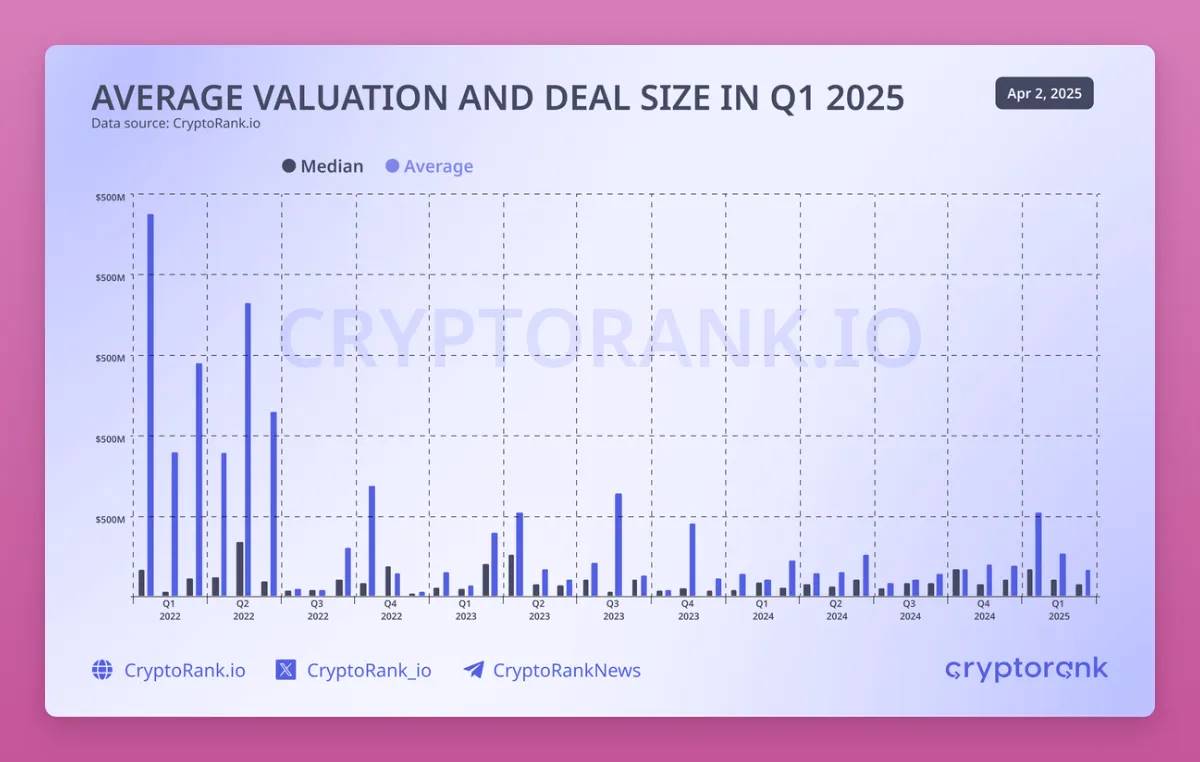
- Crypto VC funding has finally rebounded: In the first quarter of 2025, funding reached $4.8 billion, the highest level since the third quarter of 2022, with capital starting to flow into areas with real utility.
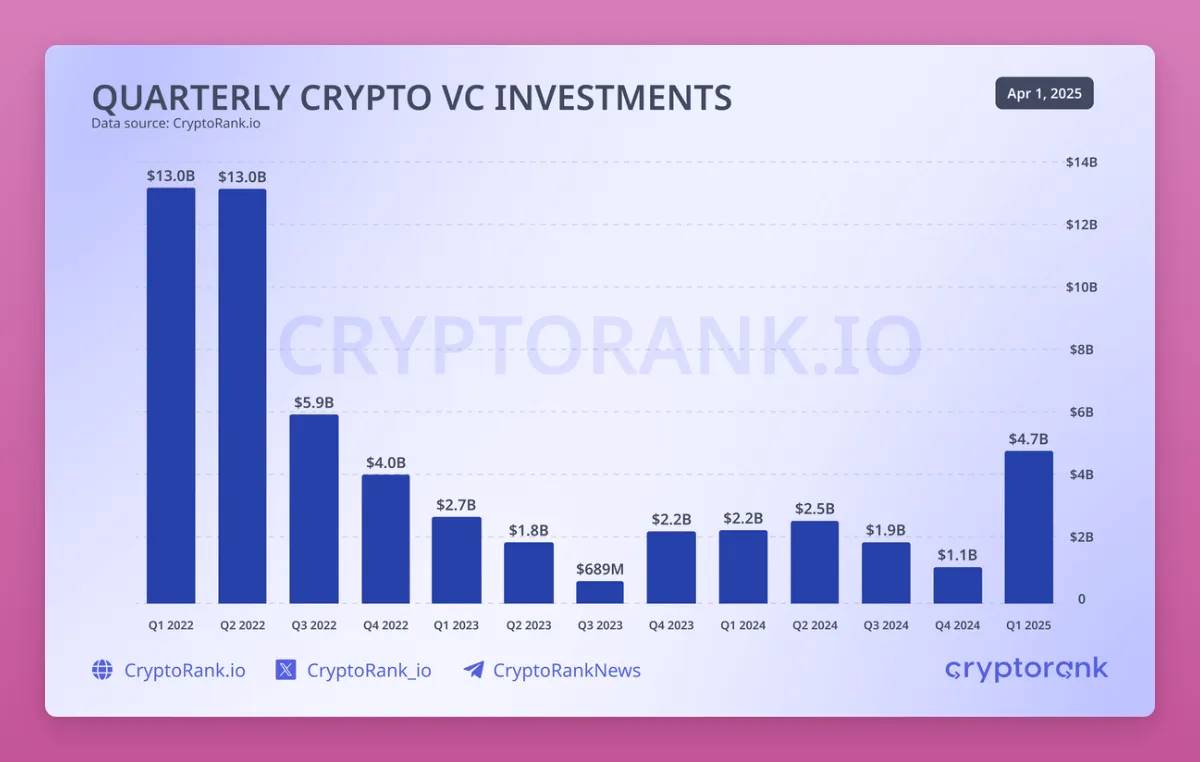
According to CryptoRank's Q1 2025 Crypto Venture Capital Status Report:
The first quarter of 2025 was the strongest since the third quarter of 2022. While the $2 billion Binance trade played a core role, there were also 12 large-scale financings exceeding $50 million, indicating a return of institutional interest.
Capital is flowing into areas with real utility and revenue potential, including centralized finance (CeFi), blockchain infrastructure, and services. Emerging focus areas such as artificial intelligence (AI), decentralized physical infrastructure networks (DePIN), and real-world assets (RWA) are also attracting strong attention.
DeFi leads in the number of funding rounds, but the scale of funding is smaller, reflecting more conservative valuations.
We are experimenting with new token issuance models to reward early supporters rather than insiders.
Echo and Legion are leading this trend, and Base has already launched a group on Echo. The Kaito InfoFi metaverse is also showing strong bullish trends, as even those without capital can benefit as long as they have social influence.
The market seems to have learned its lesson, and the ecosystem is gradually recovering (although KOLs still occupy the best resources).
Goodbye DeFi, Welcome Onchain Finance
Remember the brief narrative of yield aggregators? Yearn Finance once led the trend, followed by countless fork projects.
Now, we have entered the era of yield aggregators 2.0, which we now call "Vault Strategies."
As DeFi becomes increasingly complex, various protocols are emerging, and vaults have become an attractive option: deposit assets to earn the best risk-adjusted returns.
However, compared to the first phase of yield aggregators, the main difference now is that the level of asset management centralization is rapidly increasing.
Vaults have "strategist" teams—typically composed of "institutional investors"—who use your funds to chase the best investment opportunities. For them, it's a win-win: they earn returns using your capital while charging management fees.
Some examples include strategy teams like MEV Capital, Seven Seas, Gauntlet, and Veda, which collaborate with protocols like Etherfi, Upshift, and Mellow Protocol.
Veda alone has become the 17th largest "protocol" in DeFi, even surpassing Curve, Pancakeswap, or Compound Finance.
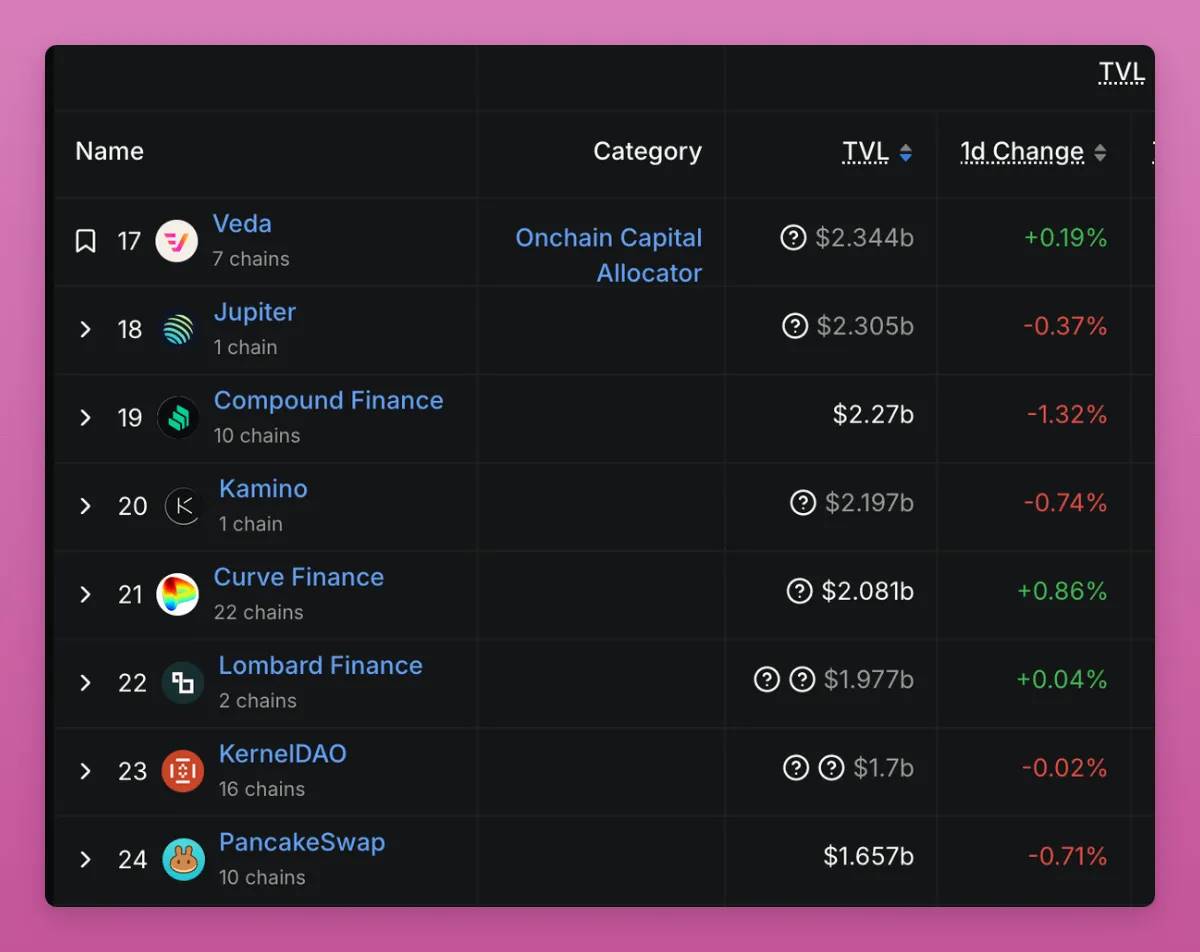
However, vaults are just the tip of the iceberg. The true vision of decentralization in DeFi has long since vanished; it has evolved into Onchain Finance.
Think about it: the fastest-growing sectors in DeFi and the crypto space are real-world assets (RWA), yield-bearing assets, and risk-free arbitrage stablecoins like Ethena and Blackrock, completely deviating from the original vision of DeFi.
Or projects like BTCfi (and Bitcoin L2), which rely on multi-signature wallets, where you must trust that the custodians won't "run away."
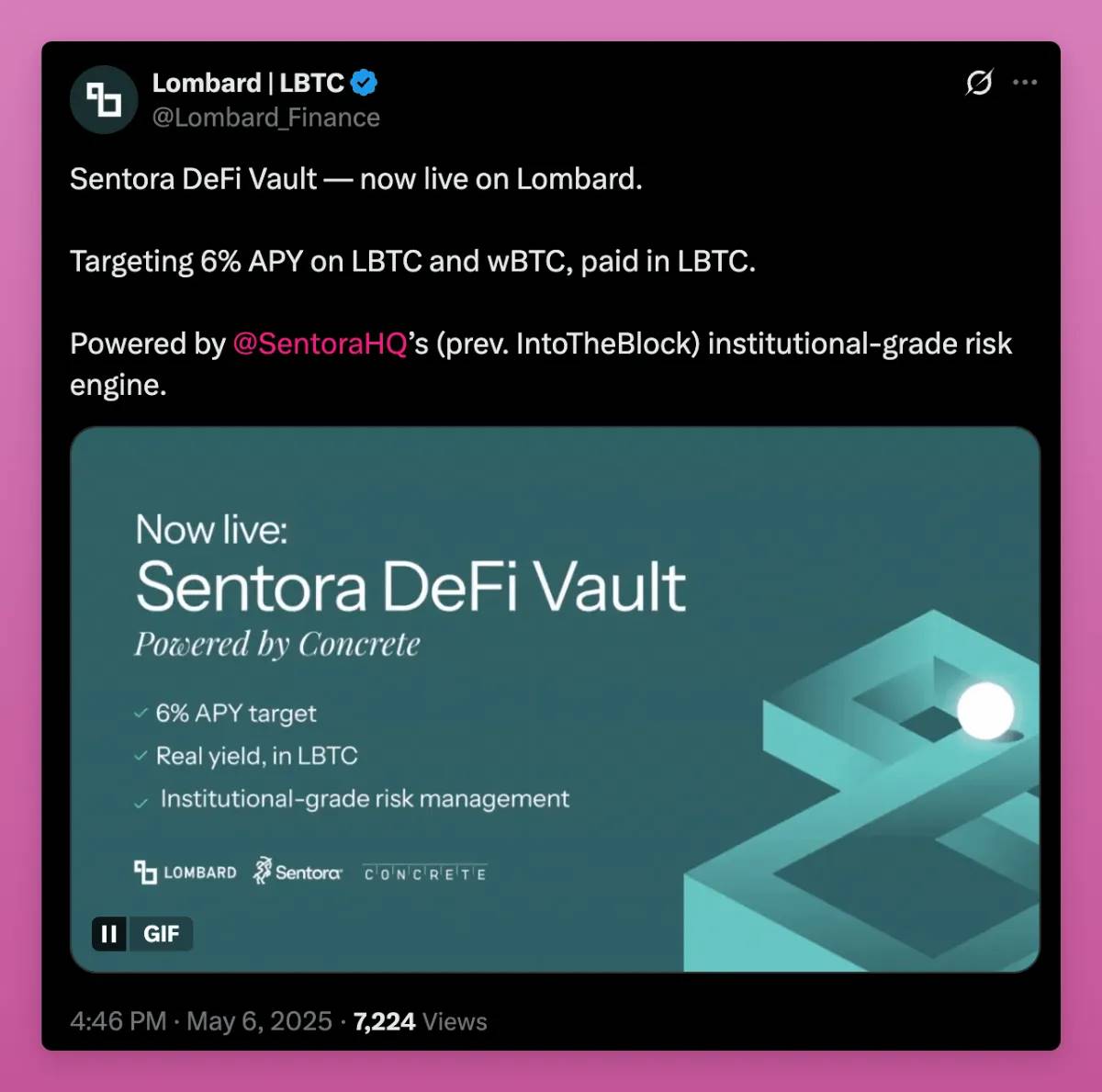
Note: This is not a critique of Lombard; it is merely an example of the trend merging vaults and BTCfi.
This trend began when Maker transitioned from decentralized DAI to yield-bearing RWA protocols. Truly decentralized protocols are now rare and small in scale (Liquity is one example).
However, this may not be a bad thing: RWA and tokenization allow us to escape the era of Ponzi schemes based on cycles and leverage in DeFi.
But it also means that risk factors are expanding, making it increasingly complex to truly understand where your funds are. I wouldn't be surprised by the misuse of user funds by CeDeFi protocols.
Remember: hidden leverage will always find a way to penetrate the system.
DAO—A Joke?
Similarly, the illusion of decentralization in decentralized autonomous organizations (DAOs) is also being shattered.
The past theory was based on a16z's "Progressive Decentralization" theory proposed in January 2020.
The theory posits:
Protocols first find product-market fit (PMF) → As network effects grow, the community gains more power → The team "hands over the baton to the community," achieving full decentralization.
However, five years later, I believe we are returning to centralization. Take the Ethereum Foundation as an example; it is becoming more actively involved in expanding L1.
I mentioned in my previous blog, "The Fearful State of the Market and Future Outlook #6," that the DAO model faces numerous issues:
Voting apathy
Increased lobbying risks (vote buying)
Execution paralysis
The DAOs of Arbitrum and Lido are moving towards greater centralization (through more active team participation or BORG mechanisms), while Uniswap has experienced significant turmoil.
The Uniswap Foundation voted to allocate $165 million for liquidity mining rewards to promote the development of Uniswap v4 and Unichain. Another conspiracy theory suggests that this funding is to meet the liquidity threshold for the Optimism OP funding program.
Regardless, DAO representatives are furious. Why should the foundation pay all $UNI rewards while Uniswap Labs (a centralized entity) has earned millions through Uniswap's front-end fees?
Recently, a top 20 representative resigned from their position as a Uniswap representative.
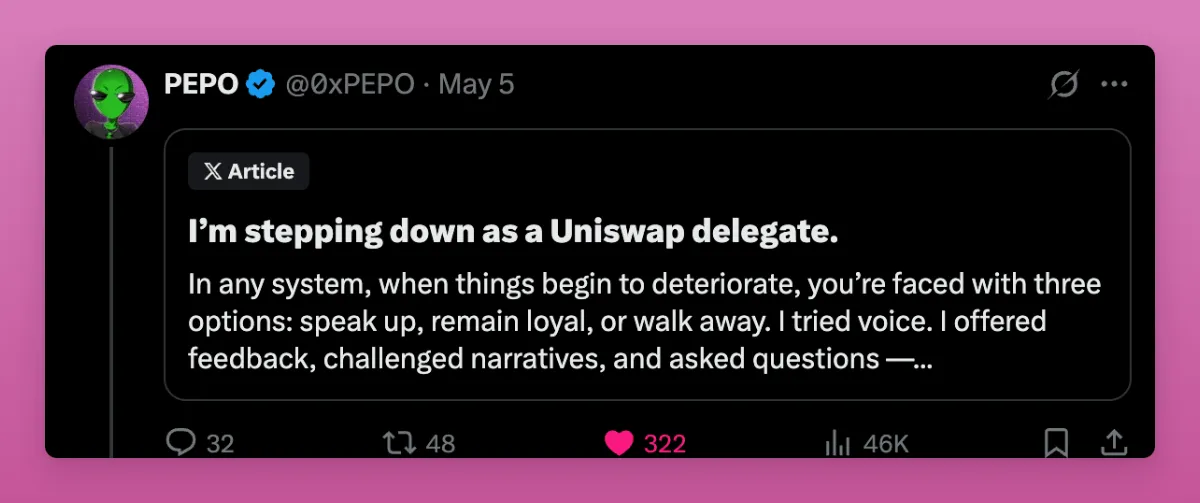
Here are the author's core points:
Governance Illusion: The Formal Governance of DAOs Uniswap's DAO appears open, but in reality, it marginalizes dissenting voices. Although proposals follow the process (discussion, voting, forum), these processes seem to have been "preordained," reducing governance to a mere "ritual."
Concentration of Power: Operations of the Uniswap Foundation The Uniswap Foundation further consolidates power by rewarding loyalty, suppressing criticism, and focusing on appearances rather than accountability.
Failure of Decentralization If DAOs prioritize branding over actual governance, they may become irrelevant. DAOs lacking true accountability resemble "dictatorships with a few extra steps."
Ironically, a16z, as a major holder of Uniswap, has failed to promote Uniswap's progressive decentralization.
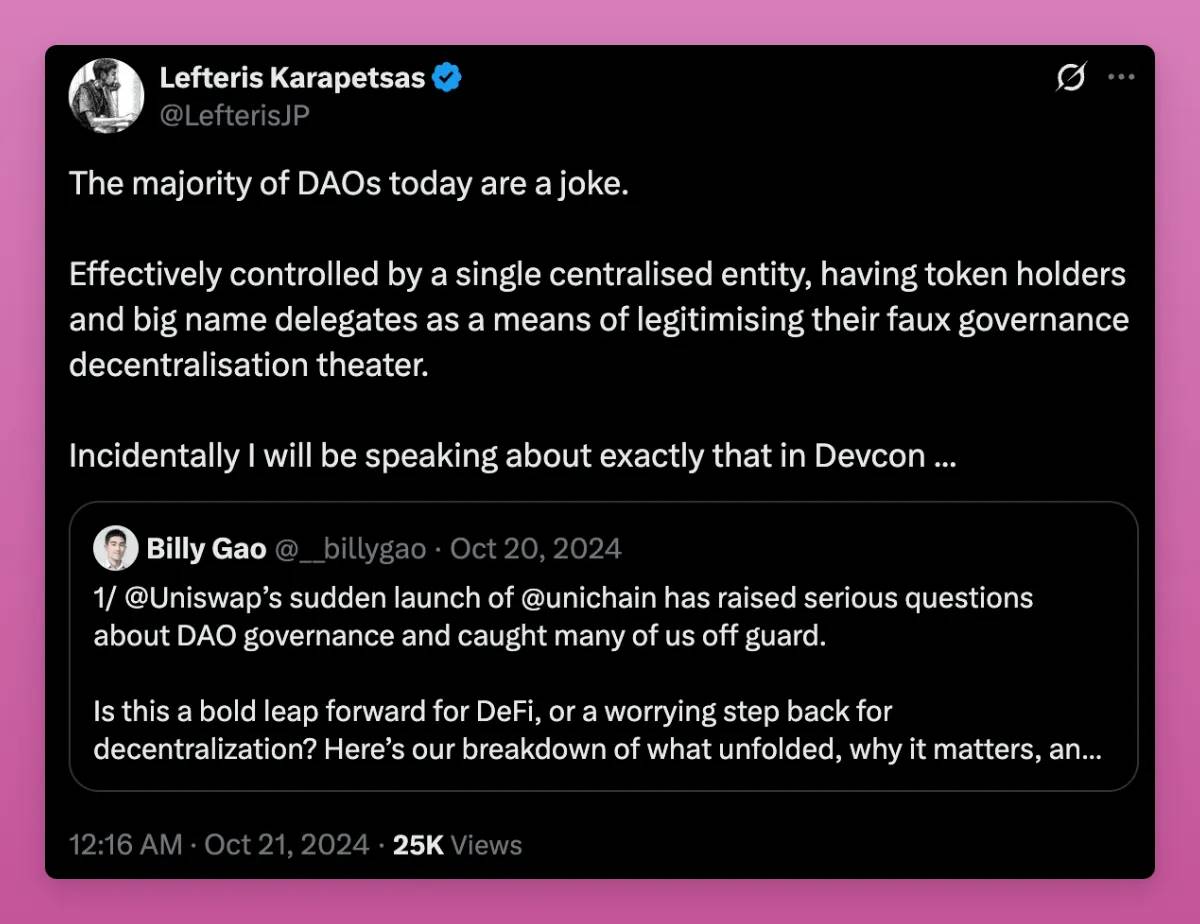
It could be said that DAOs are merely a "smokescreen" to avoid regulatory scrutiny that centralized crypto companies may face.
Therefore, tokens that serve merely as voting tools are no longer worth investing in. True revenue sharing and actual utility are key.
Goodbye DAO, welcome LMAOs—Lobbied, Mismanaged, Autocratic Oligopolies.
The Challenge of DEX to CEX: The Rise of Hyperliquid
Here’s a conspiracy theory of mine:
FTX launched Sushiswap because they were concerned that Uniswap might threaten its position in the spot market. Even if FTX did not directly launch Sushiswap, they may have provided close support in development and funding.
Similarly, the Binance team (or BNB ecosystem) launched PancakeSwap for the same reason.
Uniswap poses a significant threat to centralized exchanges (CEXs), but it has not challenged the more profitable perpetual contract trading business of CEXs.
How profitable are perpetual contracts? It's hard to know for sure, but some insights can be gleaned from comments.
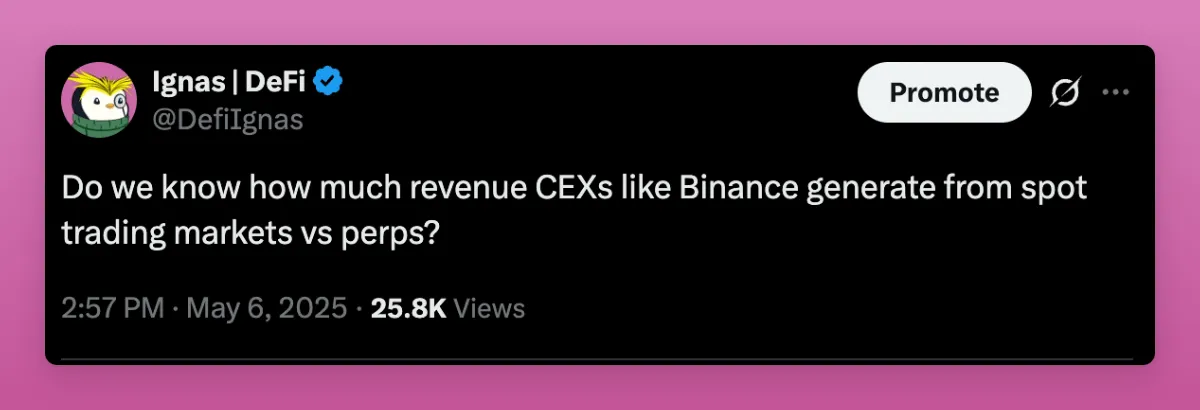
Hyperliquid, on the other hand, presents a different threat. It not only targets the perpetual contract market but also attempts to enter the spot market while building its own smart contract platform.
Currently, Hyperliquid's market share in the perpetual contract market has grown to 12.5%.
It is shocking that Binance and OKX have openly attacked Hyperliquid using JELLYJELLY. Although Hyperliquid has survived, HYPE investors must now take the potential risk of future attacks more seriously.
This attack may no longer be similar tactics but rather stem from regulatory pressure. Especially as CZ (Changpeng Zhao) gradually becomes a "national strategic crypto advisor," who knows what he will tell politicians? Perhaps, "Oh, these perpetual exchanges that don't conduct KYC are really terrible."
In any case, I hope Hyperliquid can challenge the spot market business of CEXs, provide a more transparent asset listing process, and avoid high costs that could cripple the protocol's finances.
I have a lot to say about HYPE, as it is one of the altcoins I hold the most.
But it is certain that Hyperliquid has become a movement to challenge CEXs, especially after the Binance/OKX attack.
Protocols Evolving into Platforms
If you follow my X (Twitter), you may have seen my post recommending Fluid in the context of protocols evolving into platforms.
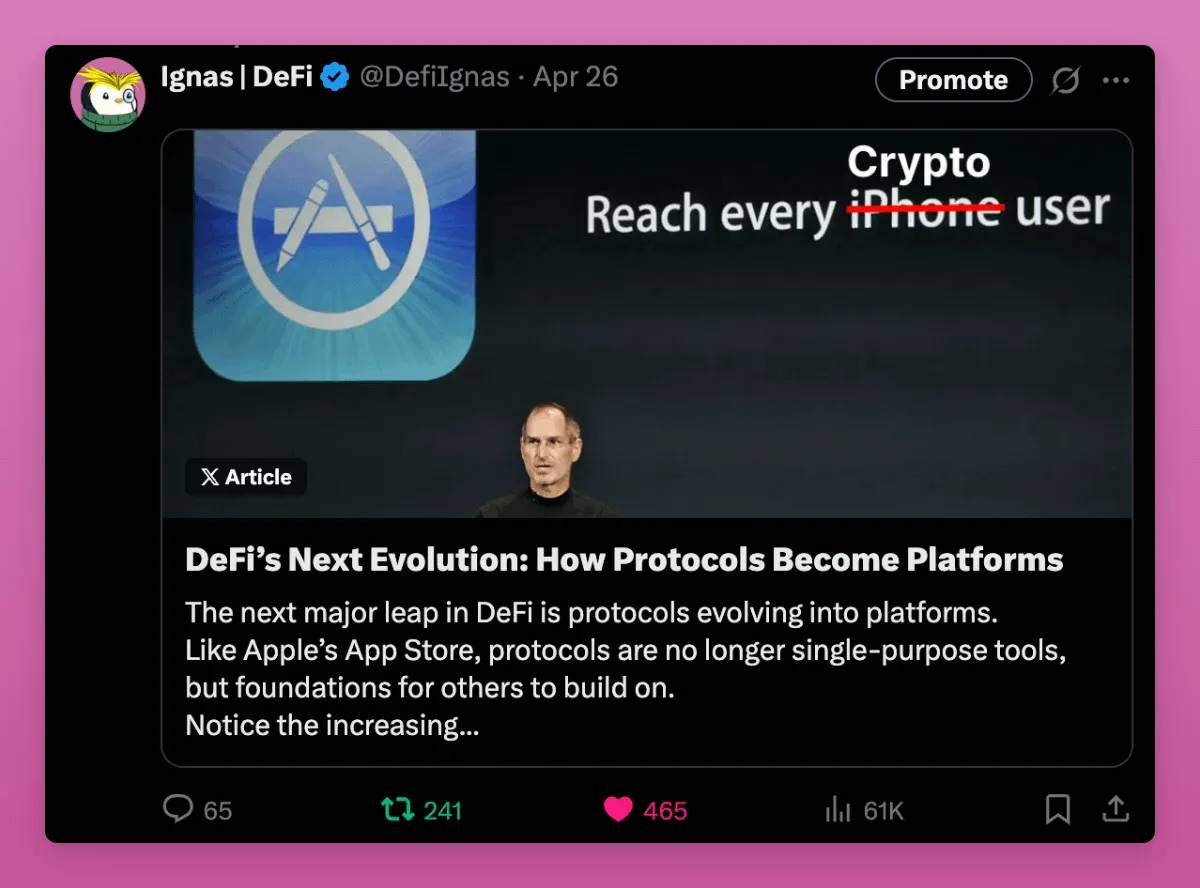
The core idea is that protocols face the risk of commoditization, while user-facing applications can capture most of the profits.
Has Ethereum already fallen into the commoditization trap?
To avoid this trap, protocols need to become like the Apple Store, allowing third-party developers to build on top of them, thereby keeping value within the ecosystem.
Uniswap v4 and Fluid are trying to achieve this through Hooks, while teams like 1inch and Jupiter are developing their own mobile wallets. LayerZero has also just announced vApps.
I believe this trend will accelerate. Projects that can capture liquidity, attract users, and monetize traffic while rewarding token holders will become the big winners.
Changes in the Crypto Industry and the New World Order
I wanted to discuss more areas of significant change in the crypto industry, from stablecoins to the disillusionment of Crypto Twitter (CT), as the crypto industry is becoming more complex.
The "Alpha" (exclusive information) that Crypto Twitter now provides is dwindling, as this industry is no longer a closed circle.
In the past, we could launch "Ponzi schemes" with simple rules, while regulators either misunderstood crypto or ignored it, thinking it would disappear on its own.
But over time, regulatory discussions have become increasingly common on CT. Fortunately, the U.S. is becoming more supportive of the crypto industry, with the rise of stablecoins, tokenization, and Bitcoin as a store of value making us feel on the brink of mass adoption.
However, this situation could change rapidly: the U.S. government may eventually realize that Bitcoin is indeed undermining the dollar's position.
The regulatory and cultural environment outside the U.S. is quite different.
The EU is increasingly focused on control, especially during the transition from welfare states to war states, with many controversial decisions being pushed under the guise of "security."
The EU has not prioritized the crypto industry; instead, it views it as a threat:
“ECB warns that U.S. crypto push could pose financial contagion risks”
“EU plans to ban anonymous crypto accounts and privacy coins by 2027”
“If blockchain data cannot be deleted individually, the entire blockchain may need to be deleted”
“EU regulators to impose punitive capital rules on insurance companies holding crypto”
We need to assess attitudes toward crypto in the context of the overall political situation. The general trend is de-globalization, with countries gradually closing their doors to entry and exit.
EU nearing visa ban for countries with "investment for citizenship" programs
In China, exit bans are becoming more frequent as political control tightens
The role of crypto in the new world order and its transition period remains a significant unknown.
When capital controls begin, will crypto become a tool for capital freedom? Or will countries attempt to suppress crypto through stricter regulations?
Vitalik explained in his “Cultural and Political Tree Ring Model” that the crypto industry is still forming its norms and has not yet solidified like banking or intellectual property law.
The internet of the 1990s took a "let it grow freely" attitude, with almost no rules or restrictions. By the 2000s and 2010s, the attitude of social media shifted to "this is dangerous, it must be controlled!" And in the 2020s, crypto and AI are still fiercely battling between openness and regulation.
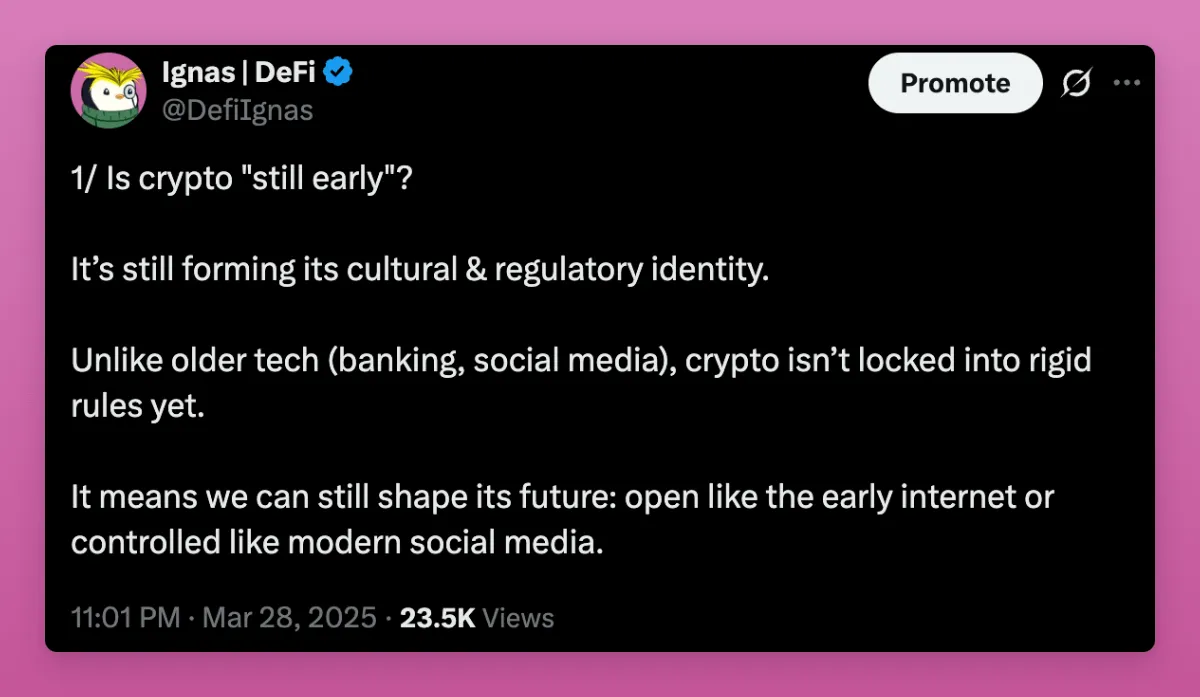
Governments once lagged behind the times, but now they are catching up.
I hope they choose to embrace openness, but the trend of globally closed borders deeply concerns me.
免责声明:本文章仅代表作者个人观点,不代表本平台的立场和观点。本文章仅供信息分享,不构成对任何人的任何投资建议。用户与作者之间的任何争议,与本平台无关。如网页中刊载的文章或图片涉及侵权,请提供相关的权利证明和身份证明发送邮件到support@aicoin.com,本平台相关工作人员将会进行核查。




